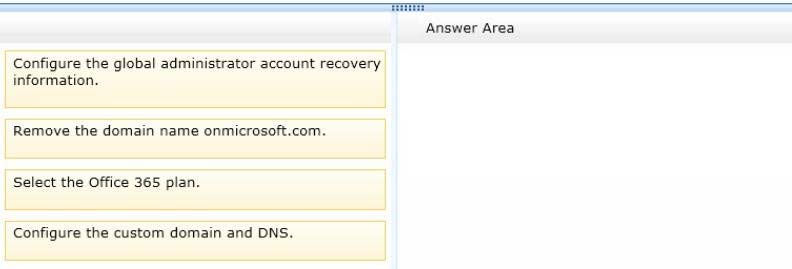
Expert Verified, Online, Free.

You administer the Office 365 environment for a company that has offices around the world. All of the offices use the same Office 365tenant.
You need to ensure that all users can access the services that are available in their regions.
Which setting or service should you update?
Correct Answer:
A
🗳️
The User Location settings will allow you to set sign-in status and user locations for all the users that are on your network notwithstanding the physical location where they find themselves.
References:
http://blogs.perficient.com/microsoft/2014/11/office-365-assign-licensing-user-location-via-active-directory/
Your company purchases an Office 365 plan. The company has an Active Directory Domain Services domain.
User1 must to manage Office 365 delegation for the company.
You need to ensure that User1 can assign administrative roles to other users.
What should you do?
Correct Answer:
D
🗳️
The Global Administrator account is similar to the Company administrator. Users in this role have access to everything or the permission to add them to a dedicated role where they do not have permission (such as discovery management and assigning administrative roles to other users).
References:
https://support.office.com/client/Assigning-admin-roles-eac4d046-1afd-4f1a-85fc-8219c79e1504
DRAG DROP -
A company plans to implement an Office 365 environment to manage email.
All user accounts must be configured to use only a custom domain.
You need to provision an Office 365 tenant for the company.
Which three actions should you perform in sequence? To answer, move the appropriate actions from the list of actions to the answer area and arrange them in the correct order.
Select and Place:
Correct Answer:

The tenant is your Office 365 account, including hosted Exchange, Skype for Business, SharePoint, and your Office 365 Active Directory. The first account that you create when you first purchase Office 365 is the "owner" of your tenant. This account should be an admin account, not a person. This account does not normally require an Office 365 license. Relating to SharePoint, all of your site collections are within your tenant. You can have any number of domains within your tenant (with e-mail accounts), but you will have only one root SharePoint URL:https://xxxx.sharepoint.com.
The Global Administrator account is similar to the Company administrator. Users in this role have access to everything or the permission to add them to a dedicated role where they do not have permission (such as discovery management and assigning administrative roles to other users).
When setting up Office 365 the first step is to purchase your subscription which includes choosing the plan. Step 2 involves the selection of the sign-on method and this is where the global administrator account is of consequence. Step 3 involves the collecting of information such as domain names and DNS, locations, etc
Step4 is the actual migration plan and schedule, step 5 the Microsoft account and organizational account, step 6 the SkyDrive and SkyDrive Pro, and step 7 the Windows Intune section.
Thus you should perform step 1 through 3 to ensure that all user accounts to make use of a custom domain for their e-mail.
References:
Katzer, Matthew and Don Crawford, Office 365 Migrating and Managing your Business in the Cloud, Apress Media, New York, 2013, pp 87- 93, 373 http://office.microsoft.com/en-gb/office365-suite-help/add-your-domain-to-office-365-HA102818660.aspx
Your company has 100 user mailboxes. The company purchases a subscription to Office 365 for professionals and small businesses. You need to enable the
Litigation Hold feature for each mailbox.
What should you do first?
Correct Answer:
A
🗳️
The first step will always be the purchasing the correct Office 365 plan to suit your needs. There are three plans of Office 365: Professional, Mid-Size Businesses, and Enterprise. The Office 365 Mid-sized businesses and Enterprise plans will allow you to enable Litigation Hold. The Professional plan is not compliant with this setting. User mailboxes that are placed under litigation hold with the external audit enabled meet all compliance requirements, because the data is immutable.
Contoso, Ltd. plans to use Office 365 for email services and Skype for Business Online. Contoso has four unique domain names.
You need to migrate domain names to Office 365.
Which two domain names should you exclude from the migration? Each correct answer presents part of the solution.
Correct Answer:
BC
🗳️
There are no practical limits on the number of domains that can be verified to Office 365 Enterprise. The rules are simple: you need to verify a domain, and you need to assign the domain based on the needs (or Domain Intent). Domain Intent is what the domain services will be configured as; there are three different types of services for Domain Intent.
A top-level domain (TLD) is the part of the domain name located to the right of the dot (" . "). The most common TLDs are .com, .net, and .org. Some others are
.biz, .info, and .ws. These common TLDs all have certain guidelines, but are generally available to any registrant, anywhere in the world.
B: contoso- single labeled domain / or also known as a second-level domain - not valid
C: contoso.local - internal labeled domain - not valid